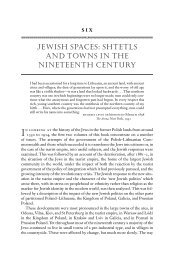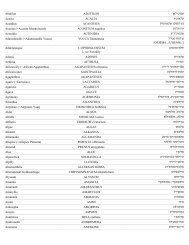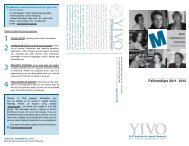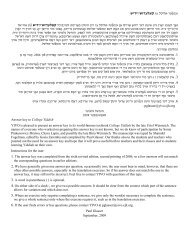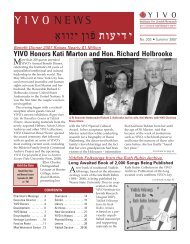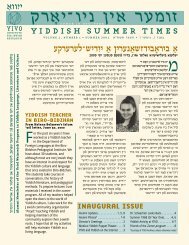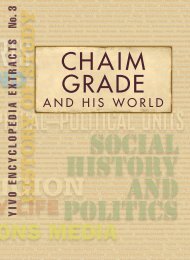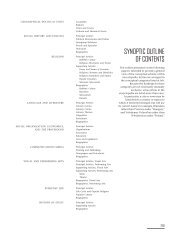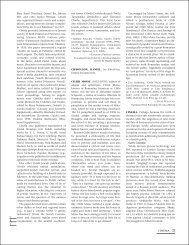Here - YIVO Institute for Jewish Research
Here - YIVO Institute for Jewish Research
Here - YIVO Institute for Jewish Research
You also want an ePaper? Increase the reach of your titles
YUMPU automatically turns print PDFs into web optimized ePapers that Google loves.
y Péter Forgácsand The KlezmaticsExhibition catalogue
Sokołów, video; 2 minutesCourtesy of the <strong>YIVO</strong> <strong>Institute</strong> <strong>for</strong> <strong>Jewish</strong> <strong>Research</strong>, New York
Museum of the History of Polish Jews18.05–30.09.2013Video installation by Péter Forgácswith music by The Klezmatics,commissioned by theMuseum of the History of Polish Jewsand the <strong>YIVO</strong> <strong>Institute</strong> <strong>for</strong> <strong>Jewish</strong> <strong>Research</strong>.The footage used comes from the collectionsof the <strong>YIVO</strong> <strong>Institute</strong> <strong>for</strong> <strong>Jewish</strong> <strong>Research</strong> in New York,the National Film Archive in Warsaw,the United States Holocaust Memorial Museum in Washington,Beth Hatefutsoth in Tel Avivand the Steven Spielberg <strong>Jewish</strong> Film Archive in Jerusalem.Exhibition organized with financial supportof the Polish Ministry of Culture and National Heritage.4 5Péter Forgács / The Klezmatics
Kolbuszowa, video; 18 minutesCourtesy of the <strong>YIVO</strong> <strong>Institute</strong> <strong>for</strong> <strong>Jewish</strong> <strong>Research</strong>, New York67Péter Forgács / The Klezmatics
eginningof the journeyAndrzej CudakActing DirectorMuseum of the History of Polish JewsThe Museum of the History of Polish Jews invites youon a journey to the Second Polish-<strong>Jewish</strong> Republic. Thisjourney begins with our first temporary exhibition, Lettersto Afar – a video installation prepared by Péter Forgács,with music by The Klezmatics.The exhibition presents the life of Polish Jews as capturedin prewar films made by American Jews duringreturn visits to their birthplaces, where they attemptedto capture <strong>Jewish</strong> life in the towns and cities of theirchildhoods <strong>for</strong> friends and family back home.The exhibition is a joint project organized within the frameworkof a partnership agreement between the Museumof the History of Polish Jews and the <strong>YIVO</strong> <strong>Institute</strong> <strong>for</strong><strong>Jewish</strong> <strong>Research</strong>. Founded in 1925 in Vilna and transferredto New York in 1940, <strong>YIVO</strong> is the most importantcenter of Yiddish Studies in the world. Its collections area treasure house of archival, library, museum, photographicand film resources on <strong>Jewish</strong> life in Poland. Homefilms from <strong>YIVO</strong>’s archival collection <strong>for</strong>m the basis ofPéter Forgács’s installation and were the inspiration <strong>for</strong>the accompanying music by The Klezmatics.89Péter Forgács / The Klezmatics
Oszmiany, video; 18 minutes 44 secondsCourtesy of the <strong>YIVO</strong> <strong>Institute</strong> <strong>for</strong> <strong>Jewish</strong> <strong>Research</strong>, New York1011Péter Forgács / The Klezmatics
a road into the openJonathan BrentExecutive Director<strong>YIVO</strong> <strong>Institute</strong> <strong>for</strong> <strong>Jewish</strong> <strong>Research</strong><strong>YIVO</strong> is pleased to enter into the first joint projectunder our new partnership agreement with theMuseum of the History of Polish Jews in Warsaw. Thisproject has great significance <strong>for</strong> both institutions. Itmarks the first <strong>for</strong>mal collaboration of the <strong>YIVO</strong> <strong>Institute</strong>with a Polish institution since the collapse of the SovietUnion in 1991, and it represents <strong>YIVO</strong>’s participation inthe awakening of new <strong>Jewish</strong> life in Poland today. Thisawakening is taking many <strong>for</strong>ms: a rediscovery of Polish-<strong>Jewish</strong> history; a resurgence in the study of Yiddishamong both Poles and Jews; a historical and moralintrospection that is the precondition <strong>for</strong> ensuring thedemocratic, liberal future of the Polish nation and theability of the <strong>Jewish</strong> people of the Diaspora to imaginewhat Arthur Schnitzler called in 1908 “The Road intothe Open.”<strong>YIVO</strong>’s home movies from the 1920s are a perfect vehicle<strong>for</strong> establishing this partnership. In conjunction with theworld renowned music of the Klezmatics and the inspiredvision of Péter Forgács this project bears the old into thenew, history into the present day, and provides a window<strong>for</strong> demonstrating <strong>YIVO</strong>’s work in public education,scholarship and artistic programming.12 13Péter Forgács / The Klezmatics
Kolbuszowa, video; 23 minutesCourtesy of the <strong>YIVO</strong> <strong>Institute</strong> <strong>for</strong> <strong>Jewish</strong> <strong>Research</strong>, New York1415Péter Forgács / The Klezmatics
LETTERS REWRITTENTamara Sztyma“There” And “Now”– Film LocationsFrom The PastPéter Forgács’s installation, Letters to Afar, is based onthe concept of addressing images, and then transmittingthese visual messages through time and space.Entering the exhibition, we are immediately surroundedby multiple images of past lives reflected on film. Likemany other films made <strong>for</strong> private use, the home moviesmade by <strong>Jewish</strong> immigrants from the United Statesvisiting their <strong>for</strong>mer homes capture unique, intimatemoments from the past, stirring feelings and allowing theviewer to be at once “there” and “now”. Warsaw, Vilna,Łódź, Kałuszyn, Kamionka, Kolbuszowa, Nowogrodek,Oszmiana, Krakow, Kurów—film locations from the past—become settings in which the action, although registeredlong ago, is played out inside the gallery. We see the lifeof locals in the streets, markets, parks, in front of homes,schools, synagogues; we follow their everyday routines
and gestures. Finally, we encounter them in the extraordinarysituation of meeting with their kin from beyond theAtlantic. It is here that family ties and relationships withinthe community are fully revealed. The scenes played outbe<strong>for</strong>e our eyes make us not only witnesses of history,but also a party to these events.For the Jews from the United States visiting their <strong>for</strong>merhomes the journey to Poland was a sentimental one: avoyage to their own lost past, as it were. The nostalgicand emotional component of these trips is evidenced bya note composed by Alexander Harkavy during his firstreturn visit to Nowogrodek in 1921: “I finally reachedthe gates of my great, beloved town [...] The sight ofNowogrodek moved me to tears. It was 43 years sinceI left the place where my cradle once stood, where Idreamed youthful dreams, where I left the grave of mymother who died be<strong>for</strong>e her time.” Visitors’ feelings werea mixture of hope and fear. Curious about the changesthat had occurred, they still wanted to find the placesthey remembered from the past. “After 43 years I wasexpecting a lot of changes, but the market square lookedexactly the same,” Harkavy wrote. “On the other handI noticed a great change in the population, the marketplace seemed much less peopled […] yet I was happy tosee that modern <strong>Jewish</strong> culture had reached this placetoo.” The visitors, if they had cameras, recorded films withthe intention of showing them to relatives in America.They documented familiar places, families in their dailysurroundings, playing games, going on walks, waving tothe camera, sending greetings, and visiting the graves ofancestors. Next to the joy of these meetings, these filmsalso express the distance and sense of alienation that setthe filmmakers apart from their relatives in Poland. Theeveryday life of the provincial towns they observed stoodin stark contrast to the modern life of <strong>Jewish</strong> immigrantsin New York, the most modern city in the world, whilstalso the heart of modern Yiddish culture.Focused on capturing the inner life of local communities,these films provide a meaningful glimpse of the autonomyand richness of <strong>Jewish</strong> life in interwar Poland. School,youth, self-help and cultural organizations existed ineven the smallest towns, operated not only by localcommunities, but also assembled around political movements,both national and religious. This broad social1617Péter Forgács / The Klezmatics
Kamionka, video; 14 minutesCourtesy of the <strong>YIVO</strong> <strong>Institute</strong> <strong>for</strong> <strong>Jewish</strong> <strong>Research</strong>, New York1819Péter Forgács / The Klezmatics
spectrum can be discerned especially in the films madeby members of American “landsmanshafts”, organizationsof immigrant Jews from the same locality, whichoften tried to organize help <strong>for</strong> their <strong>for</strong>mer communitiesin Poland. Pesach Zukerman’s film, shot in 1929 on behalfof the Kolbuszower Relief Society, was just such a reporton the economic and social conditions of the local <strong>Jewish</strong>community in Kolbuszowa. Thanks to numerous screeningsof the film in the United States, the society raisedfunds not only <strong>for</strong> the citizens of Kolbuszowa, but also <strong>for</strong>those of nearby towns, including Sokołów, Rzeszów andRaniżów. Similarly, the film from Nowogrodek was madeby Alexander Harkavy, president of the NowogrodekRelief Committee in New York, which the citizens ofNowogrodek had turned to <strong>for</strong> help in 1930. These andmany other films show the difficult economic situation ofthe <strong>Jewish</strong> population throughout interwar Poland—onethat only worsened as the economic crisis deepenedand anti-Semitic attitudes became more pronounced.During this period, many Polish <strong>Jewish</strong> organizations,as well as <strong>Jewish</strong> entrepreneurs and retailers, barelymanaged to make ends meet, dependent on the financialsupport of <strong>Jewish</strong> organizations from abroad—financingthat was distributed through a network of loan associations(“gmiles chesed”) set up in towns and citiesthroughout Poland.Concentrating on smaller towns and the lives of largelyimpoverished relatives, visitors seldom turned theircameras on in the large urban areas that functioned asthe birthplaces of vibrant political and cultural life—thosecities that were home to an active <strong>Jewish</strong> intelligentsiaand witnessed the rise of <strong>Jewish</strong> press, theater, cinema,politics and sports. Thus, although these films provide anaccurate picture of <strong>Jewish</strong> towns, they do not give a completeview of <strong>Jewish</strong> life in interwar Poland, where, asidefrom religious life and autonomous <strong>Jewish</strong> institutions,there was also increasing polonization and assimilation,coupled with the rise of a modern <strong>Jewish</strong> culture. Thisaspect of <strong>Jewish</strong> life is only dimly present in theseamateur films, mostly visible in the modern appearanceof the young men and women who stand in contrast tothe traditional lifestyles of their parents and grandparents.Above all, modern Polish <strong>Jewish</strong> life is best expressedin shots of the busy streets of Warsaw, Łódź and Vilna,moments captured by the camera of Gustaw Eisner, atravel agent originally from Łódź who organized trips<strong>for</strong> Americans to their native lands. “I set my camera inmotion as soon as the ship pulled out of the New Yorkharbor. I am recording my whole trip and hope in thisway to share with my friends when we return to Americaall that we have seen,” Eisner wrote to a friend in 1931.During his two visits to Vilna, Eisner also filmed import-
Warsaw, video; 35 minutesCourtesy of the <strong>YIVO</strong> <strong>Institute</strong> <strong>for</strong> <strong>Jewish</strong> <strong>Research</strong>, New York2021Péter Forgács / The Klezmatics
Vilna, video; 13 minutesCourtesy of the <strong>YIVO</strong> <strong>Institute</strong> <strong>for</strong> <strong>Jewish</strong> <strong>Research</strong>, New York2223Péter Forgács / The Klezmatics
ant historical moments, including the groundbreakingceremony <strong>for</strong> the <strong>YIVO</strong> <strong>Institute</strong> <strong>for</strong> <strong>Jewish</strong> <strong>Research</strong>,the funeral of Tsemah Shabad, leader of the Vilna <strong>Jewish</strong>community, and a mourning procession after the death ofmarshal Józef Piłsudski.Returning several decades later to these films created by<strong>Jewish</strong> travelers, Péter Forgács reconstructs the “visualpostcards” written by them, filtering them through hisartistic sensibility with a new addressee in mind—themuseum visitor of the 21st century. Forgács selectsspecific frames from these films based on subjectivecriteria. He then replays these fragments at differentspeeds, breaking the images up into frieze compositions,adding to them some natural soundscape and the musicof The Klezmatics, who offer a modern reinterpretationof traditional <strong>Jewish</strong> sounds. In this manner, the artistcomposes over a dozen audiovisual “orchestrations” thatare played simultaneously within the exhibit, where thedifferent sizes and shapes of these projections developthe dynamics of the exhibition space. Employing thesedevices, Forgács paraphrases and reinterprets the ef<strong>for</strong>tsof the original filmmakers, who largely intended to showthe films to their relatives in America, offering their audiencean opportunity to enter, if <strong>for</strong> just a moment, a differentspace in which they could be together with thoseportrayed on film. Forgács manipulates these imagesin order to heighten the viewer’s attention to everydaymoments from lives whose distance from us is no longerdefined by space, but by time—moments separated fromus not by an ocean, but by a gulf of eighty years.Like the original filmmakers who registered the gesturesof their kin be<strong>for</strong>e the cameras, Forgács is above all interestedin the behavior of people—their looks, gestures,and mutual interactions. His gaze, even more so thanthe amateur’s camera, enters the private world of thoseon screen, and tracks their fragile, intimate moments byripping individual frames from the whole, underscoringthem by isolating them, and sometimes adding additionalemphasis through the repetition that the frieze structureof the triptych allows. Ultimately, Forgács exposes theseimages and their subjects anew, as it were, be<strong>for</strong>e theviewer’s eyes, and tries to penetrate into the privateworld of people from a different place and time—childrendance, hands clasp, women cast seductive glances,a man grabs a hat blown off by the wind, an elderlywoman turns away her wig-covered head.Forgács does not strive to create a historical panorama;his aim is not to build a great historical narrative. While atension between the desire to depict the private world of
families and to capture the wider social context pervadesthe amateur interwar films, in the adaptive work of theartist there is a tension between micro- and macrohistory.In order to anchor the individual perspectivewithin the context of the era, he includes additional,archival footage from The Banner of Freedom, a Polishfilm made in 1935 that shows the history of Poland’srebirth and reconstruction under marshal Piłsudski. Keyfigures and moments from the interwar history of Polandappear in these selected scenes, where we witness thePolish Legions in battle, Piłsudski’s arrival in Warsaw inNovember 1918, Ignacy Paderewski representing Polandat the Versailles Conference, the Polish-Bolshevik War of1920, Piłsudski receiving the marshal’s baton, the MayCoup, Ignacy Mościcki assuming the presidency, and theconstruction of the Gdynia seaport.The dance-like tension between public and private historyis also developed through the discreet textual commentaryinserted into the films by the artist, <strong>for</strong> which he usescitations from memoirs, letters and literature that refer togeneral facts as well as individual events and people. <strong>Here</strong>,he also rewrites the intentions of the original filmmakers,who largely relied on orally explaining the silent footage <strong>for</strong>their American audiences, mostly family members. Whilescreening, there were moments of spontaneous narrationwhen the names of places and people were pronouncedaloud. In a similar way, the artist’s commentary focuses theviewer’s attention, indicates direction, and provides a counterpointto the flow of impressions and thoughts stimulatedby the projections. Like the creators of these films, Forgácsdistances himself from the world shown therein. Whereas,<strong>for</strong> the <strong>for</strong>mer, the distance between the filmmaker and thatwhich was filmed was created by the cultural and economicdifferences between <strong>Jewish</strong> life in American metropolisesand in little towns in Poland, that which dictates the artist’sdistance is historical consciousness. Although, unlikein his other works, in Letters to Afar Forgács tries not toemphasize this post-Holocaust perspective, neither henor today’s audience can fully escape it. There<strong>for</strong>e, Forgácssubtly arranges the projections so as to give the space somesacred overtones. He not only presents triptychs, but alsouses a monumental vertical screen in the central area of thegallery, a presentation that echoes altar compositions. Thiscreates another sort of tension: as the viewer succumbsto the seductive dance of “there” and “now”, he cannotfully sever himself from the opposite thought lurking onthe horizon—that of being “here” and there<strong>for</strong>e beingconscious of what happened “then”. In what measure welet ourselves be seduced by “fragments of life” from the past,or think of the broken continuity of that life, is a matter ofindividual perception.2425Péter Forgács / The Klezmatics
Zaręby Kościelne, video; 11 minutesCourtesy of the <strong>YIVO</strong> <strong>Institute</strong> <strong>for</strong> <strong>Jewish</strong> <strong>Research</strong>, New York
The sacred and monumental air of the exhibition is alsoenhanced by inviting the viewer to climb the staircase“to heaven,” that is—to a small upper gallery dedicatedto films recalling the world of <strong>Jewish</strong> tradition. <strong>Here</strong>, anamateur film from the traditional <strong>Jewish</strong> neighborhoodof Kazimierz in Krakow, is accompanied by scenes fromThe Dybbuk, a 1937 feature film based on the play byS. An-sky. The plot, set within the world of Chassidicbeliefs and legends, reflects the Kabbalistic view of theworld as a single organism that draws its vital energyfrom God. Bringing attention to the spiritual side of Judaictradition is by no means a univocal statement or elegiacaccent. On the contrary, it demonstrates the vitality oftradition. The young Chassidim on the streets of Krakowbelong to a new generation, a part of which still chosereligion in response to the challenges of modernity. TheDybbuk, one of several Yiddish-language films made ininterwar Poland and shown in movie theaters across thecountry, represents the phenomenon of modern <strong>Jewish</strong>culture, one capable of creatively combining the secularand popular sphere with tradition and religion.past. Both the footage recorded by interwar filmmakersand its artistic retransmission by Forgács are letterswritten from a specific perspective, <strong>for</strong> a specific purposeand audience. What is common to both of these perspectivesis the desire to capture life, not only in a documentarianand historical fashion, but also in an existentialdimension meant to establish a connection between thefilmed world and those to whom the films are addressed.Rather than being an elegy, Forgács’s installation isa tribute to life. By rediscovering and revising materialfrom the <strong>YIVO</strong> <strong>Institute</strong> <strong>for</strong> <strong>Jewish</strong> <strong>Research</strong>, the artistinvites us to a rereading and reliving of “letters” from the2627Péter Forgács / The Klezmatics
Zaręby Kościelne, video; 11 minutesCourtesy of the <strong>YIVO</strong> <strong>Institute</strong> <strong>for</strong> <strong>Jewish</strong> <strong>Research</strong>, New York28 29Péter Forgács / The Klezmatics
The Visitor’s Gaze RevisitedJeffrey ShandlerOn American Jews’Films of Travelsto Interwar PolandThough we have made this glorious country as oursecond home, living under far better conditions andenjoying more freedom under the American flag, we stillfeel and consider in the depths of our hearts our nativetowns with all its shadows and faults as the sunny spotof the first happy years. Looking upon the schools, synagogues,and all the other unique features prevalent inour idealic [sic] towns, we feel as a shock of pride wouldtouch us and many a tear relieves our very sensitivehearts while looking at these pictures and recalling thefirst episodes of our early lives.”—opening of “A Pictorial Review of Kolbishev,” producedby the Kolbuszower Relief Society, 1929.
Among many novelties of Polish <strong>Jewish</strong> life in the twodecades following World War I, one of the less noticedat the time has since become among the most prized: thecreation of several dozen amateur films of Polish <strong>Jewish</strong>communities, recorded by <strong>for</strong>mer residents of theselocales on visits from abroad. These films are a hybridof the home movie, as it is conventionally understood—adocument of family gatherings at birthday parties, holidaypicnics, and the like—and the travel film, recordingadventures while on vacation in a resort or <strong>for</strong>eign city.Indeed, these films of immigrant Jews’ visits to Polandare home movies of a special kind—documenting thetravelers’ <strong>for</strong>mer homes <strong>for</strong> screening in their new homes.The defining subject of these films is not the visitor’sdestination per se, but the visit itself; they document theencounter between the visitor and the visited.These films are an outcome of a larger phenomenon ofthis era: return visits to Poland and other East Europeancountries by Jews who had immigrated, primarily tothe United States, the most common destination ofthe approximately two million Jews who left EasternEurope between the 1880s and the start of WorldWar I. After a generation of large-scale movement awayfrom Eastern Europe, these return visits reflect changesin the diaspora of Polish Jewry responsive, in turn, tothreshold developments in postwar life on both sides ofthe Atlantic: in Europe, the struggle to recover from thewar’s economic devastation in new countries establishedin place of the Habsburg and Romanov empires; in theUnited States, an economic boom and the enactment ofrestrictive quotas curtailing mass immigration. As morethan three decades of steady arrival of Polish Jews tothe United States came to an end, their American-bornchildren came of age, nurtured in an immigrant culturedefined by negotiating the disparities between the moresof their parents’ <strong>for</strong>mer and current homes. Concurrently,the Second Polish Republic offered Jews both new possibilitiesas citizens of a democracy and new challenges asan ethnic and religious minority in a freshly independentpolity facing the task of recovery from a devastating war.American Jews’ visits to <strong>for</strong>mer homes in Poland inthe 1920s and 30s gauged the extent to which theseimmigrants’ lives had diverged from the communities inwhich they had been born and raised. At the same time,these journeys demonstrated the powerful hold that3031Péter Forgács / The Klezmatics
Kolbuszowa, video; 23 minutesCourtesy of the <strong>YIVO</strong> <strong>Institute</strong> <strong>for</strong> <strong>Jewish</strong> <strong>Research</strong>, New York3233Péter Forgács / The Klezmatics
their hometowns had on the Jews who had left theseplaces behind.American Jews traveled back to Poland <strong>for</strong> a variety ofreasons: on personal trips to see relatives and friends, indelegations from relief agencies providing economic aid,as scholars or artists eager to steep themselves in theculture of East European Jewry. These trips all entailed asymbolic engagement with Poland, defined by the natureof visiting itself. Each trip was a planned stay <strong>for</strong> a limitedperiod of time, bracketed by lengthy journeys to andfrom their destination, and culminated in a return to thetraveler’s new home in the United States. Central to thesymbolic value that these visitors assigned to Poland wastheir understanding of Europe as the Old World, a chronotope—thatis, a conceptual interrelation of time andplace—locating a personal as well as a collective past.Through these travels, immigrant Jews both renewed tiesto their <strong>for</strong>mer homes and affirmed the new lives theyled in America.As travelers do today, these visitors documented theirtrips, whether to share the experience with others upontheir return or to consolidate the brief, intense encounterwith <strong>for</strong>mer homes <strong>for</strong> their own remembrance andto affirm their sense of self. Most often these recordsof travel took the <strong>for</strong>m of letters, postcards, diaryentries, or still photographs. Films of these trips wereless common, <strong>for</strong> a variety of reasons. Portable motionpicture cameras <strong>for</strong> amateur use were relatively new, aswas stable 16mm film stock (“safety” film supersededmore volatile nitrate film in the early 1920s). Filmmakingequipment was much more expensive than what wasrequired <strong>for</strong> still photography. In the early 1920s, anew Cine-Kodak movie camera cost close to half theprice of a new Ford Model T automobile. Early moviecameras were more cumbersome than the Brownie orother snapshot cameras of the era and required skills tooperate that relatively few amateur photographers hadin the 1920s and 30s. And once the footage was developedscreening films required the additional purchaseof a projector. Those travelers who filmed their visitsto Poland in these decades were distinguished by theirrelative prosperity and their commitment to using stateof-the-arttechnology.Though this medium provided unprecedented opportunitiesto record moving images, it had its limitations.Footage was recorded without sound; the images wereblack and white. The lighting required <strong>for</strong> sufficient exposureof the film usually restricted shooting to outdoorlocations, and the length of a reel limited how long a
filmmaker could shoot without reloading the camera toabout ten minutes.Most of the films that American Jews made of returntrips to Poland during these years document travelundertaken <strong>for</strong> personal reasons. These films appear tohave been shot by the visitors themselves and were likelymeant to be shown only to families and friends. A fewfilms were intended <strong>for</strong> somewhat larger audiences, suchas those made <strong>for</strong> screening to a landsmanshaft, an organizationof immigrant Jews from the same hometownin Europe. These films were likely used to raise fundsamong landsmanshaft members to aid their relativesand <strong>for</strong>mer neighbors in Poland, who struggled with thepostwar economic recovery and, during the late 1930s,economic discrimination.The structure of all these travel films usually resembleshome movies of the period. They typically consist of anepisodic series of discrete shots, loosely organized, ratherthan a running narrative sequence structured throughmontage. Some films, especially those made <strong>for</strong> largeraudiences, incorporate intertitles that either identifypeople and places, or comment, at times playfully, onthe footage. These travel films center on documentingthe visitors’ search <strong>for</strong> the <strong>for</strong>mer quotidian—the places,people, and activities once familiar to these travelersin their childhood hometowns. The camera records thevisitors’ gaze, beholding the environment of their pastand taking stock of changes. Shots often pan acrosslandscapes and crowds or, when dealing with smallersubjects, especially people, remain fixed, as if the photographerwere taking a still picture.At the same time, the camera’s presence frequently interruptsthe course of daily life, demanding attention. Crowdsare assembled in order to meet the American visitors and tobe filmed; babies are lifted up to bring them into the camera’sview; families stand framed in doorways of homes or stepout from inside, in single file, parading be<strong>for</strong>e the camera.People often stare back at the photographer, at timesawkwardly, appearing unsure what to do. Occasionally theyaddress the camera (saying what?) or smile and wave theirhands (to whom?), perhaps offering greetings to relativesin America who will eventually see them on the screen. Thecamera simultaneously facilitates communion betweenPolish Jews and American visitors and articulates thedistance between these two centers of the East European<strong>Jewish</strong> diaspora.The encounter between Polish Jews and their visitorsfrom abroad, often implicit in these films, becomes3435Péter Forgács / The Klezmatics
Sokołów, video; 2 minutesCourtesy of the <strong>YIVO</strong> <strong>Institute</strong> <strong>for</strong> <strong>Jewish</strong> <strong>Research</strong>, New York3637Péter Forgács / The Klezmatics
eadily apparent when the American travelers appear oncamera, whether embracing and frolicking with locals orpraying and weeping beside the graves of their ancestors.As still photos documenting these trips also demonstrate,Americans presented themselves to the photographerdifferently than did Polish Jews, who generally appearless at home be<strong>for</strong>e the movie camera—an instrumentwielded by persons, once familiar as relatives or neighbors,who have been trans<strong>for</strong>med by their Americanness,the change evident on screen in their dress andcomportment.These films thus conjoined an innovative medium witha novel social phenomenon—the visit to Poland fromAmerica. The camera became a vector <strong>for</strong> tracing a newkind of connection between immigrants and their <strong>for</strong>mercommunities. While the visitors’ gaze is more obviously retrospective—beholdingthe world of their childhood—it alsoconsiders the prospects of their fellow Jews in Poland. Thistension is especially apparent in the films made to help infundraising. For example, a 1935 film screened at a banquetof the Sędziszów landsmanshaft opens with an exhortationto the immigrant <strong>Jewish</strong> audience in New York to reflect ontheir hometown’s past and, implicitly, to consider its future:“Sędziszów, as we knew it, has vanished. Its remains struggles[sic] desperately <strong>for</strong> life amidst suffering and starvation,with only little relief in sight. The scenes following depictpart of miserable conditions prevailing. Reminiscences of ouryouth will now take us back to the very cradle of our birth. Itssons and daughters, who have here attained high positionsin social and commercial life and achieved financial success,have trodden the paths of this now desolated community. “Indeed, all these films leave unanswered the question—asked, perhaps tacitly, by both Polish Jews and theirimmigrant visitors: When will we see one another again?This question may have been voiced not only when thesetravel films were shot but again when they were screened.Like home movies generally, especially those recordedwithout sound, they would have been accompaniedby commentary when shown to family and friends. Ineffect, this live, impromptu chatter completed the films,not only identifying the people and places depicted butalso offering expansive narratives that link the images ofthe visit to decades of memories extending beyond whatappears on screen.After World War II, this footage has acquired a profoundlydifferent symbolic value, one scarcely imaginedby either the filmmakers or their subjects in the 1920sand 30s. Prized even more than still photographs of interwarPolish Jewry, given these films’ relative scarcity and
their animation, they seem to “bring to life” a destroyedworld with unrivaled fullness. At the same time, thefilms’ ostensive aliveness also calls attention to theirincompleteness: Who were these people? What werethey saying? What color were their clothes? What werethey doing inside the buildings seen only from outside?And what, ultimately, became of them all?Over the years, the destruction of these communitieshas been compounded by the passing away of the filmmakersand others of their generation who could providethese films with their original “sound track.” Their silencebecomes emblematic of these multiple losses—of individuals,communities, cultures, and those who, sharingtheir origins, could remember visiting these people <strong>for</strong> afew days in the respite between world wars.As these films have become more antique, and theirsubjects grow more remote and obscure, they havebecome more compelling, provoking desires to <strong>for</strong>ge newengagements with them. In the decades following WorldWar II, many a filmmaker has sought to contextualizethese films with narration, sound effects, and music inthe numerous documentaries that have sampled thisfootage. These documentarians’ “discovery” of interwartravel films in the <strong>YIVO</strong> <strong>Institute</strong> and other collectionscoincided with musicians’ “discovery” of klezmer musicon vintage 78-RPM recordings, sometimes in the samearchives. It is there<strong>for</strong>e fitting that this installation bringstogether Péter Forgács, a filmmaker renowned <strong>for</strong> hisinventive work with vintage amateur footage of mid-20thcentury Europe, and the Klezmatics, a leading <strong>for</strong>ce in thetrans<strong>for</strong>mation of the traditional instrumental music ofEast European Jews. Rather than deploying these filmsinstrumentally, as records of actuality, in order to presentcinematic narratives of the prewar <strong>Jewish</strong> past, theseartists make the films a subject of interest in their ownright. Both Forgács and the Klezmatics call our attentionto the medium and its mediating practices by disruptingfilm’s simulation of an actuality. These artists invite usto revisit with fresh eyes and ears these brief reunions ofJews in the far-flung diaspora of Polish Jewry, united andrefracted by the vector of moving images.3839Péter Forgács / The Klezmatics
Kolbuszowa, video; 23 minutesCourtesy of the <strong>YIVO</strong> <strong>Institute</strong> <strong>for</strong> <strong>Jewish</strong> <strong>Research</strong>, New York4041Péter Forgács / The Klezmatics
searching <strong>for</strong> overlooked imagesJoanna AndrysiakpÉter<strong>for</strong>gÁcs’workOld, black and white film reels. Their conditionreminds us that they come from a time long past.Smiling people at the family table or bathing in a lake.Feeding a newborn baby. Happy, posing <strong>for</strong> a cameraheld by someone they trust. This is the imagery of FreeFall (1996) and of most of Péter Forgács’ other films. Itis only the layer of sound he adds (here, a reading ofGerman wartime decrees radically limiting the rights ofJews) and the dates appearing on the screen that tell usthat the scenes, filmed by György Petö, come from the1940s. And that the film’s protagonists shared the fateof Hungarian Jewry – a fate that the amateur filmmaker’scamera could not record.
It is difficult to say what compels an artist to build hiswork almost exclusively out of archival images created bysomeone else. Perhaps the distressing signs of decay visibleon nearly every inch of celluloid, and the lasting sense ofsatisfaction that he might save from oblivion the memoriesstored thereon. Or yet a weariness of the Great Narrativesthrough which the complex history of the 20th century isusually told, and the desire to portray the past through theeyes of those omitted in such master narrations.In the case of Forgács, one of the best known Hungarianexponents of found footage, the artist’s fascination canbe traced back to 1983, when he founded the PrivátFotó és Film Archívum (Private Photo and Film Archive)in Budapest. To gather its collection, the artist traveledthroughout Hungary, visiting family homes, archivingold films and conducting interviews. The collection thusbuilt inspired the “Private Hungary” series (1998-2002),whose fourteen parts present the chronicles of severalHungarian families, juxtaposing impressions of life inHungary with important political events. “In Hungary […]eleven different political rules existed between 1918 and1989, (including three revolutions and two counterrevolutions)[…] As a consequence, any family home-moviecollection […] will show the unique sign of the times,”Forgács explained in an interview.In “Private Hungary”, next to the story of the Petö family,we also get to know the story of the Hungarian bishopLaszlo Ravasz, persecuted both by the Nazis and theCommunists (The Bishop’s Garden, “Private Hungary”14, 2002). We also discover the stories of bourgeoisfamilies fighting against the nightmare of Communism(Either – Or, “Private Hungary” 3, 1989), or the film diaryof Baroness Jeszenszky (The Notes of a Lady, “PrivateHungary” 8, 1994), a rare record of the life once led byHungarian aristocracy. The amateur filmmakers whoregistered these films all shared an enormous passion<strong>for</strong> cinematography as well as an enthusiasm <strong>for</strong> newtechnologies in general. For them, the camera was amarvelous, nearly magical device.While working on the subsequent parts of “PrivateHungary” the artist also made ef<strong>for</strong>ts to obtain homemovies from all over Central Europe as well as otherEuropean countries. As a result, Forgács’ portfolio of4243Péter Forgács / The Klezmatics
Kurów, video; 10 minutes 26 secondsCourtesy of the <strong>YIVO</strong> <strong>Institute</strong> <strong>for</strong> <strong>Jewish</strong> <strong>Research</strong>, New York44 45Péter Forgács / The Klezmatics
over 30 films and over 30 visual installations includesdepictions of the Hungarian emigration to the UnitedStates at the beginning of the 20th century, the Germanoccupation in Holland and Greece, and the Spanish CivilWar. In his latest film – German Unity @ Balaton (2011),the political trans<strong>for</strong>mation in East Germany is portrayedthrough a juxtaposition of the vacation films of Germansspending their holidays at lake Balaton with the documentsof the GDR Ministry of Security which kept thesefamilies under surveillance.Common to all of Péter Forgács’ films is a nostalgicmood, particularly inherent in the slow-motion dynamicsof many of the takes, and the minimalist music of TiborSzemzö, whom the filmmaker works with on a regularbasis. One often gets the impression that the images arearranged <strong>for</strong> the music and not the other way around—afact confirmed by the artist himself. One of the rulesof this “patchwork game” is to “let the music carry theemotional story.” One easily <strong>for</strong>gets that the artwork,the story which gains a fictional dimension, is in realitya skillfully arranged sequence of documental shots. Theirreference to reality is all the more tangible because unlikeprofessional documentarians, their authors—amateurfilmmakers—filmed their own private world. WhatForgács attempts to do in his film practice is primarily toproduce new meanings from this extant archival footage.“It is always very intriguing <strong>for</strong> me,” he says, “when Iimagine how someone else might have constructed awholly different cinematographic meaning based on thesame material.”Forgács’ style has a distinctive character, not onlyesthetically, but also because of what his films make usrealize about the turbulent history of the 20th century,and there<strong>for</strong>e also about history in general. A fragmentfrom his film, El Perro Negro. Stories from the Spanish CivilWar (2005), which portrays Spain in the 1930s througha combination of films by the Salvans family and ErnestoNoriega, is highly representative of a large portion ofhis work. In one particular clip, a figure jumps into ariver, accompanied by a caption that reads “On July 18,1936, civil war broke out.” The juxtaposition of this keyhistorical fact with the image of an undisturbed momentof happiness and relaxation reminds us that private livesand events of national importance run parallel to oneanother, and that even the most momentous historicalcalamities do not immediately ruffle the course of privateexistence.Equally provocative are the playful antics in front of thecamera in the opening scene of El Perro Negro, or the
images of Hungarian or Dutch Jews enjoying familialhappiness, coupled with our awareness of the dangershanging over them at the time. These happy momentsfrom the era’s private lives trouble the master narrativesof history, acting as an obverse whose reverse is thehistory of wars, genocide and Communist repression. Thefact that this “reverse” is absent from the footage itself,and present only in the viewer’s mind, can be attributedto the nature of home movies as such—one cannotexpect anyone to want to save difficult and unpleasantmoments from oblivion. Private films, as the artist says,are always a “nostalgic family album [...], family stories,home get-togethers, tourist views, etc.”But sometimes the two sides of the single story told by theartist come together to <strong>for</strong>m a particularly horrifying narrative.A perfect example of this is a scene from The Maelstrom.A Family Chronicle (1997), a film in which the Peereboomfamily of Dutch Jews is preparing <strong>for</strong> departure to what theythink is a labor camp in Germany. As it turned out, the familywas shipped to the death camp in Auschwitz-Birkenau. Aswe watch the grandmother and mother sitting at the table,mending children’s clothing, talking and smiling at eachother, their ignorance of what is to come fills us with terror.This is very much Forgács’ intent. “This is a powerful motif[that] gives an uncom<strong>for</strong>table feeling <strong>for</strong> the viewers,” hesaid in an interview. “It is like the suspense in a Hitchcockfilm. We know ahead of time that the innocent victim willfall into the hands of the killer. We want to warn her or him:watch out! And our palms are sweating. We can’t help, andhere—in my films—it anticipates real blood, real suffering.We always have that in mind, even if we never see it in myfilms.”The Maelstrom is also an extraordinary example of howForgács highlights the paradoxes of history. The blackand white home movies of Max Peereboom, showing hisfamily’s daily life from 1932 to 1942, are set alongsidethe color home movies of Arthur Seyss-Inquart, theGerman Reichskommissar <strong>for</strong> the Netherlands. Out ofthe many emotions that might be evoked by the sight ofthis man’s smile and happy moments, the most powerfulconclusions are drawn by the viewer precisely from thetension of this troubling contrast. We watch Seyss-Inquarttalking to his family while they are skating, kissing hisgranddaughter, playing cricket with his wife and children.The family scenes from the lives of people whose fatesproved so different—the victims, who perished in 1942, andtheir oppressors—do not differ in any substantial way.Another extraordinary example of Forgács’ depiction ofthe paradoxes of history is The Danube Exodus (1998), a4647Péter Forgács / The Klezmatics
Zaręby Kościelne, video; 11 minutesCourtesy of the <strong>YIVO</strong> <strong>Institute</strong> <strong>for</strong> <strong>Jewish</strong> <strong>Research</strong>, New York4849Péter Forgács / The Klezmatics
film and artistic installation created by Forgács duringhis stay as an artist-in-residence at the Getty Museumand Getty <strong>Institute</strong> in Los Angeles in 2000-2002, andpresented at several museums around the world. The60 minute film was made in 1998 from footage shot byNándor Andrásovits, the captain of a Danube cruise shipwho documented his travels around Europe. The purposeof the first trip that attracted Forgács’ attention was totransport Hungarian Jews to the Black Sea, where theywere to board a ship bound <strong>for</strong> Palestine. A year laterAndrasovitz made another voyage. This time he wastransporting German farmers, natives of Bessarabia, whowere fleeing the Red Army and being <strong>for</strong>cefully resettledto Nazi-occupied Poland. In his film, Forgács decidedto stress, as he puts it, the “incomparable duet of theGerman-<strong>Jewish</strong> exodus.” Choosing these two particularvoyages from the archive of Captain Andrásovits, he<strong>for</strong>ces the audience to compare the obviously terrifyingposition of the Jews in the 1930s with the uncommonsituation of the German citizens. All of these peoplewere <strong>for</strong>ced to leave behind their homes and lives, the<strong>for</strong>mer as refugees, in constant danger, the latter as legalrepatriates. Despite the similarity of their exoduses, themood of each group was entirely different. While theBessarabian Germans, facing no threat of imminentdeath, were mourning the loss of their homes and estates,the Jews danced and rejoiced, because though they hadlost everything, their lives had been saved.It is also worth noting whom Péter Forgács chooses as theprotagonists of his films. Apart from a few exceptions, suchas Istvan Bibo or Ludwig Wittgenstein, whose thoughts areread against the background of film clips in A Bibó Reader(2001) and Wittgenstein Tractatus (1992), the heroes of hisfilms are usually ordinary people whose names and storieswe would never have known if it were not <strong>for</strong> Forgács’ works.Despite their ordinariness, Forgács treats his subjects witha piety usually reserved <strong>for</strong> History’s superheroes. The filmEl Perro Negro. Stories from the Spanish Civil War is a perfectexample of this approach. By incorporating an incidentalmotif into the title and inserting the image of a black dogat various points in the film, the filmmaker stresses thathe is interested in what is completely insignificant fromthe viewpoint of greater history: the images it overlooks.Ultimately, Forgács’ film is, above all, a record of the storyof a certain family—a couple of people and a black dog,perhaps belonging to them, but not to history with a capital“H” and its possessive rhetoric. In an interview, the artiststated: “There is a duty to tell my history because there is no“History” anymore. There are his- stories and her- stories.So the duty is to tell your story and my story. It’s a kind ofdeconstruction.”
It is not only historical narrative that Forgács deconstructs,but also the reservoir of material from which hecreates his works: the archive. For it is not without significancewhether the footage used comes from privatecollections, to which the artist attaches a great value, orfrom public archives, often embroiled with institutionalpower. Archival practice is never indifferent, neitherwhen it consists in photographing and filming reality,the memory of which someone decides to keep, nor inthe process of gathering and organizing already existingfootage. In each case, it is affected by choice.This reflection on the nature of archival images isperhaps most evident in Forgács’ “Col Tempo” – The W.Project, an installation which the artist presented at the53rd International Art Exhibition in Venice in 2009. Thismulti-dimensional work was in large measure composedof photographs and film fragments featuring faces thatturn and look at the viewer. Key to their interpretationwas the provenance of the material. It had been commissionedby Josef Wastl, a scholar and member ofthe NSDAP, who was also head of the AnthropologyDepartment of the Museum of Natural History in Viennafrom 1938 until 1941. In 1939, Wastl organized an exhibitionentitled The Physical and Spiritual Appearance ofthe Jews, which included material confiscated from the<strong>Jewish</strong> Museum in Vienna, police identity photographs ofJews, and the results of a racial study conducted on 440<strong>Jewish</strong> men of Polish origin. The men were photographed,hair samples were collected from 105 of them, andplaster masks were made from 19 of their faces. Throughthese studies, anthropologists contributed directly to themurder of Jews: their classification determined the fateof the individuals whose race was studied. The purposeof the Viennese exhibition was to encourage visitors toask themselves, upon leaving, whether their neighbors orthose they passed by in the street, whose features boreresemblance to those they had just seen, were not by anychance <strong>Jewish</strong>.The Wastl archive was thus above all a tool of objectification;in the photographs, the Jews were not recognized assubjects, but objects to be classified. The artist restorestheir subjectivity by finding those who survived—aninterview with one of them was presented as part ofthe installation. This shows that an archive created asan instrument of oppression can still be redeemed. Thisdistinct trans<strong>for</strong>mation, however, is only effected in theviewer’s experience.Those who have the chance to experience Forgács’ workare often left with haunting images of faces. It is on the5051Péter Forgács / The Klezmatics
films’ faces that the viewer’s attention usually comes torest, because the moving image is time and again frozenon them. This is how the filmmaker reminds us that thepeople on the screen are no longer there, that they andtheir world have passed. Resurrecting the films in whichthey appear, and especially focusing our attention onthem <strong>for</strong> a longer moment, is a <strong>for</strong>m of commemoration.The substratum of these films—the damaged celluloidonto which they have been recorded—is undeniably asymbol of the loss of memory. The memory that PéterForgács strives to preserve.
Kałuszyn, wideo; 13 minutesCourtesy of the <strong>YIVO</strong> <strong>Institute</strong> <strong>for</strong> <strong>Jewish</strong> <strong>Research</strong>, New York5253Péter Forgács / The Klezmatics
Kolbuszowa, wideo; 23 minutesCourtesy of the <strong>YIVO</strong> <strong>Institute</strong> <strong>for</strong> <strong>Jewish</strong> <strong>Research</strong>, New York5455Péter Forgács / The Klezmatics
Films usedin the installation:Amateur films of :Zaręby Kościelne and Warsaw (1930–1939),Krakow (1935),Kałuszyn (1935–1936),Kolbuszowa (A Pictorial Review of Kolbishev, 1929),Kamionka and Skidl (shot by Gerold and Lillian Frank, 1934),Vilna, Łódź and Warsaw (shot by Gustaw Eisner, 1929–1935),Gródek (shot by David Shapiro, 1935),Oszmiana (1937) and KurówFrom the collection of the <strong>YIVO</strong> <strong>Institute</strong> in New YorkAmateur film shot by Benjamin Gasul in Warsaw, 1939From the collection of the United States Holocaust MemorialMuseum in Washington (Steven Spielberg Film and Video Archive)Novogrudok, amateur film shot by Alexander Harkavy, 1931From the collection of Beth Hatefutsoth in Tel-AvivA Day in Vilna and A Day in Warsaw from the Five cities series,directed by Saul Goskind, produced by Isaac Goskind, 1939From the collection of the Steven Spielberg <strong>Jewish</strong> Film Archivein JerusalemThe Dybbuk, directed by Michał Waszyński, produced by LudwigPrywes, Poland 1937From the collection of the National Film Archive in WarsawThe Banner of Freedom, directed by Ryszard Ordyński, produced byFalanga, Poland 1935From the collection of the National Film Archive in Warsaw
FILM locations from the past(map of poland be<strong>for</strong>e 1939)VilnaOszmianaGródekKamionkaSkidelNowogródekZaręby KościelneWarsawKałuszynŁódźKurówKolbuszowaSokołówKrakow5657Péter Forgács / The Klezmatics
texts usedin the installation:Shalom Soroka, Kałuszyn – Our Town, in: Sefer Kalushin; geheyliktder khorev gevorener kehile (The Memorial Book of Kaluszyn),ed. A. Shamri, Sh. Soroka, Tel Aviv 1961Arye Rozenzon, Betar in Kurów; Sura Ajzensztadt, This Is HowI Saw Kurów, in: Yizker-bukh Koriv; sefer yizkor, matsevet zikaronle-ayaratenu Koriv (Yiskor Book in Memoriam Of OurHometown Kurow), red. M. Grossman, Tel Aviv 1955Michael Peled, A Small <strong>Jewish</strong> Village, of Blessed Memory;Zelda Ziskind, My Village and My Street; Aliza Gofstein,Oshmana – My Hometown, in: Sefer zikaron le-kehilat Oshmana(Oshmana Memorial Book), ed. M. Gelbart, Tel Aviv 1969Pinkas Navaredok (Naveredok memorial book),ed. E. Yerushalmi, Tel Aviv 1963Gerold Frank, The Elders of Kamionka, 1938 (“The Nation”)Alexander Harkavy, Navaredok, New York 1921Norman Salsitz, A <strong>Jewish</strong> Boyhood in Poland. RememberingKolbuszowa, Syracuse 1990Zusman Segałowicz, Tłomackie 13. Fun farbrentn nekhtn,Buenos Aires 1946Jakov Pat, Fun noentn over, New York 1956Lucy S. Dawidowicz, From That Place and Time, a Memoir1938-1947, New York 1989Ber Rozen, Tłomackie 13, Buenos Aires 1950Alfred Döblin, Reise nach Polen, Berlin 1924 (Alfred Döblin,Journey to Poland, transl. by Joachim Neugroschel,New York 1991)
Video installation: Péter ForgácsMusic: The Klemzatics, featuring Frank London, Matt Darriau,Lisa Gutkin, Lorin Sklamberg, Paul Morrissett and Richie Barshay(special guest - John Mettam)Exhibition curator: Tamara SztymaSenior advisor: Barbara Kirshenblatt-GimblettMHPJ project director: Katarzyna Nowakowska-Sito<strong>YIVO</strong> project director: Suzanne Leon<strong>YIVO</strong> project coordinator: Krysia FisherVideo editor: Péter Sass2nd video editor: Zoltán VidaSound editor: Tamás ZányiGraphic design: Anna Rzeźnik, Kasper Skirgajłło-KrajewskiIllustrations: stills from films from the collection of the<strong>YIVO</strong> <strong>Institute</strong> <strong>for</strong> <strong>Jewish</strong> <strong>Research</strong>Texts edited by: Magdalena ProkopowiczPolish proofreading: Dominik WódzTranslation: Dominika Gajewska, Maria ZawadzkaEnglish proofreading: Denise GrollmusPrinted by: Edit5859Péter Forgács / The Klezmatics
Place name, video, 0:00 min.Courtesy of the <strong>YIVO</strong> <strong>Institute</strong> <strong>for</strong> <strong>Jewish</strong> <strong>Research</strong>, New York
6061Péter Forgács / The Klezmatics
Published by:The Museum of the History of Polish Jews6 Anielewicza St.00-157 WarsawISBN: 978-83-928380-5-0© Copyright byMuseum of the History of Polish Jews,Warsaw 2013© Copyright by<strong>YIVO</strong> <strong>Institute</strong> <strong>for</strong> <strong>Jewish</strong> <strong>Research</strong>,New York 2013



